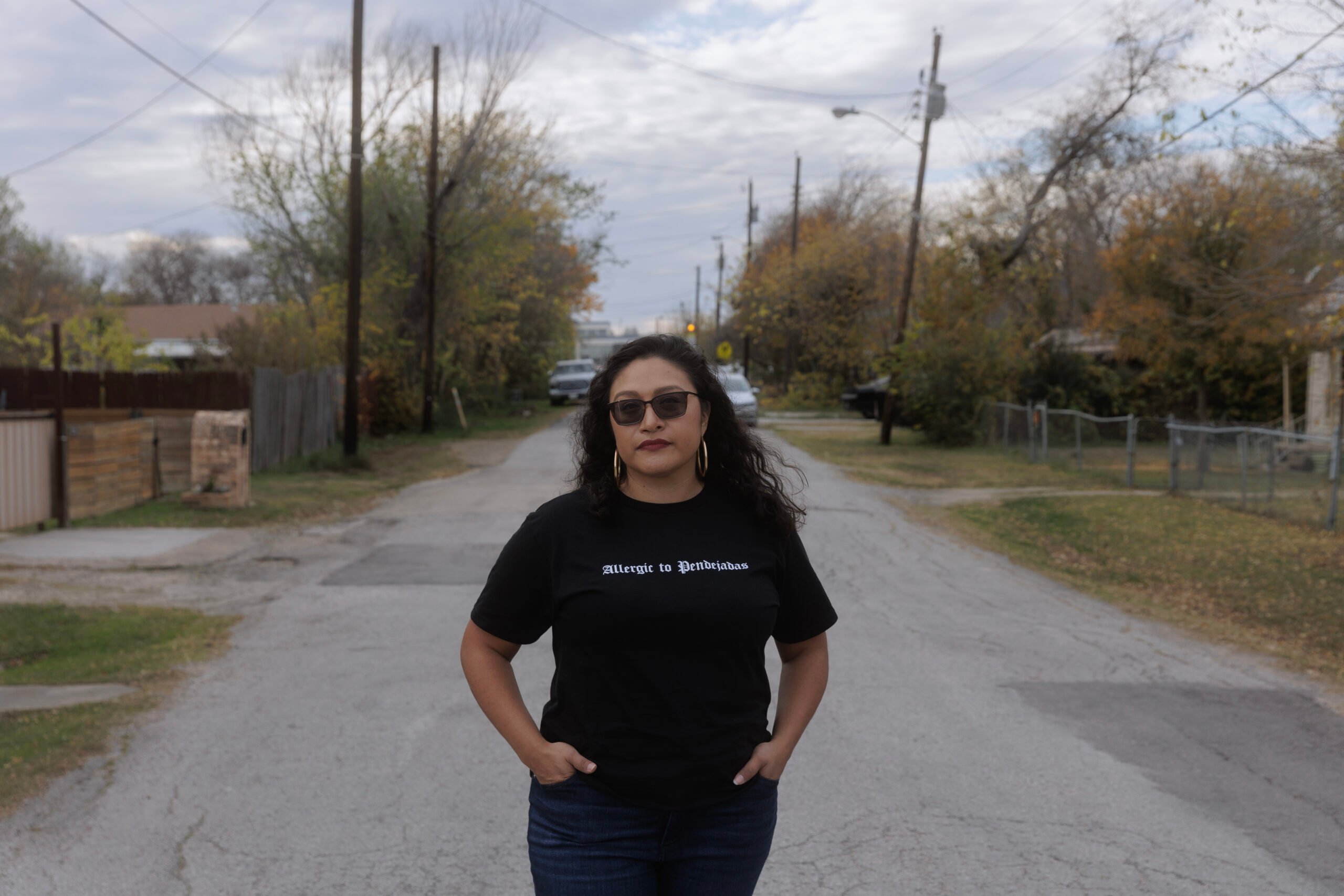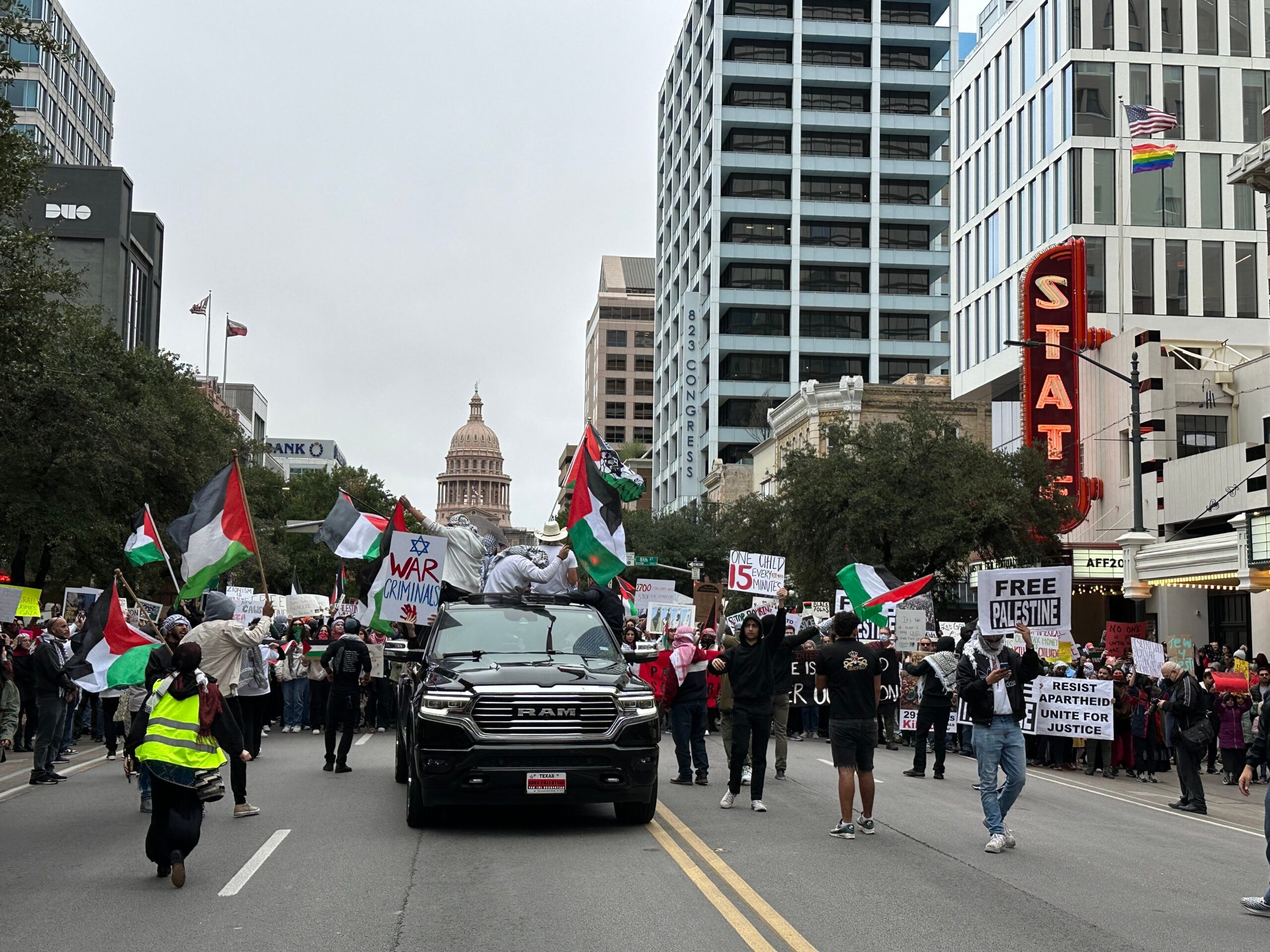Above: Janie Cisneros, founder for the Singleton United/Unidos neighborhood group, helped fight against the GAF factory until it reclassified itself as minor and averted public participation requirements in 2022.
This article originally appeared on Inside Climate News, a nonprofit, independent news organization that covers climate, energy and the environment, and the Texas Tribune. It is republished with permission. This is the final part of State of Denial, a series about Texas’ environmental regulators.
When the Intercontinental Terminals Company sought a permit to expand its tank farm and terminal on the Houston Ship Channel in 2014, a reviewer with Texas’ environmental regulator expressed a long list of concerns.
ITC, the reviewer for the Texas Commission on Environmental Quality wrote, appeared to be evading core provisions of federal environmental law by dividing its “major” facility among nominally separate “minor” permits, which have less stringent pollution standards requirements and require far less review.
In Greater Houston, federal authorities had set a threshold at 25 tons per year of volatile organic compound emissions. Any company wanting to release more was required to undergo a tedious, expensive application process, established in the Clean Air Act, as a so-called “major source.”
ITC had already obtained permits for its first group of chemical tanks in 2012 for 24.9 tons per year of volatile organic compound emissions in 2014. Now it was asking to permit a second group for another 24.9 tons per year. Because both groups fell conveniently just under the EPA’s threshold, neither were subject to a federal program called New Source Review, or NSR.
“We have concerns about NSR circumvention,” wrote the permit reviewer, Jesse Lovegren, in a July 2014 email to other agency staff.
Nevertheless, ITC got its permit the next year. And in 2017 it got another for an even larger expansion, bringing its authorized emissions of volatile organic compounds up to 147 tons per year — almost six times Houston’s current major source threshold.
Yet the facility never underwent the process required by federal law for major sources, which is aimed at preventing current air pollution hazards in places like Greater Houston from getting worse.
It wasn’t an isolated error, according to attorneys and regulatory experts in Texas and beyond, but an example of a systemic problem with emissions permitting in the Lone Star State, seat of the nation’s largest oil, gas and petrochemical sectors. By exploiting the legal distinction between major and minor pollution sources, lawyers have argued repeatedly in court papers, companies can dodge pillars of the country’s landmark environmental laws.
“This is sort of a foundational problem with Texas permitting, and it’s leading to a lot of harm,” said Gabriel Clark-Leach, a former staff attorney for the Environmental Integrity Project, a nonprofit law firm based in Austin. “It’s so important for sources to be considered minor because it makes the whole permitting process less expensive and it makes operation of the plant less expensive.”
Inside Climate News compiled 10 recent cases involving allegations the TCEQ characterized major pollution sources as minor. An investigation by ICN and the Texas Tribune, based on hundreds of pages of government and court records and dozens of interviews, revealed numerous ways in which large companies sidestep major source permitting:
They may, like ITC, characterize different parts of their facilities as independent minor sources; they may dramatically underestimate the amount of pollution they say they will emit; they may classify their emissions in unregulated categories; or they may use retroactive amendments to change the conditions of original permits after facilities are built.
Systemic abuse
Clark-Leach, 47, said he saw companies use these tactics during each of his 13 years with EIP, but legal challenges were rarely successful. He and other public interest attorneys have alleged in legal filings that the TCEQ often acts to facilitate the maneuvers.
They also named another, unexpected agency as complicit in lax permitting: the Environmental Protection Agency.
While regulators in many other states also neglect to stop companies from evading major permits, said Ryan Maher, an attorney who has studied the problem for two years on a grant from the Funder Collaborative on Oil and Gas, what sets Texas apart is the EPA’s unwillingness to intervene, especially in application and enforcement of nonattainment limits.
“Texas is given a total pass,” said Maher, who works for the Center for Biological Diversity in Maine. “Texas oil and gas is getting a huge handout relative to the rest of the country.”
In September, Clark-Leach filed a petition with the EPA denouncing TCEQ’s handling of ITC, then left the Environmental Integrity Project, frustrated and discouraged. Now Clark-Leach, tall with a short, graying beard, is writing a play while he contemplates his future.
“It’s been really tough trying to attack the TCEQ’s abuses. That’s one of the reasons why I threw my hands up and left. I didn’t see any way forward on this issue, which is a major issue,” he said.
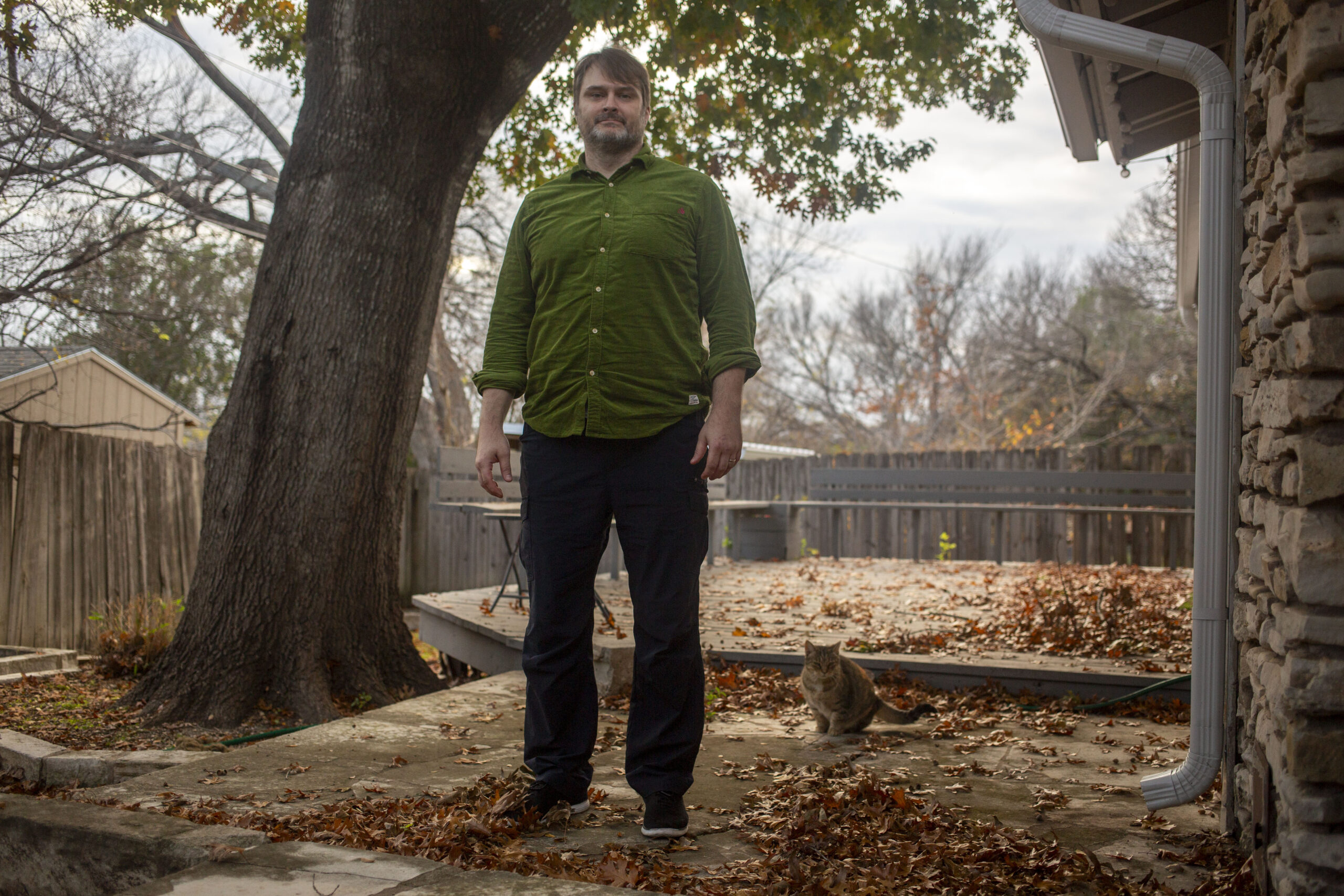
The TCEQ, headed by three appointees of Texas Gov. Greg Abbott, grants thousands of pollution permits each year, including hundreds for major sources. The 10 cases analyzed in this investigation constitute a tiny fraction of those permits. In most of them, nonprofit watchdogs or federal regulators alleged improper use of minor source permits to authorize major sources; in others, companies utilized legal loopholes to avoid more stringent pollution controls.
In one case, the EPA rejected Texas’ proposed permit for a seawater desalination plant at the Port of Corpus Christi, saying the TCEQ had mischaracterized it as a minor source; TCEQ issued the permit anyway.
In another, a Gulf Coast gas liquefaction plant received a minor source permit to annually emit 6 tons of nitrogen oxides, then released more than 120 tons during its first year of operation.
In another, an 80-year-old West Dallas shingles plant faced community outrage and EPA objections over its major source permit renewal, so it voided its application and applied as a minor source, which doesn’t require public input or federal oversight.
In another, a gas booster station and emergency gas flaring operation in West Texas with a minor source permit to release 0.01 tons per year of sulfur dioxide emitted more than 250 tons per year, the major source threshold, in “excess” emissions, each year from 2017 to 2020.
EPA Region 6 spokesperson Jennah Durant, responding to criticism about the agency’s failure to hold TCEQ accountable, said Texas holds “authority to implement most environmental programs and regulations in the state” while EPA retains “oversight authority.”
“EPA welcomes any specific input or correspondence regarding the execution of these roles,” Durant said.
ICN shared its findings with the TCEQ, but the agency declined to comment on any of the specific examples.
TCEQ spokesperson Richard Richter wrote in an email that the process of evaluating pollution permit applications “consists of a highly complex review,” including “in-depth analyses of many factors including, but not limited to, Best Available Control Technology, emission rate calculations, off-property impacts analysis, major new source review applicability, and review of applicable state and federal rules.”
The process typically involves requests for more information or design changes from the TCEQ and a lengthy back-and-forth with the applicant, Richter said. “After this detailed process is complete, TCEQ issues authorizations that are in compliance with all rules and regulations.”
Richter said specific questions from ICN “are either better suited for EPA or will require a Public Information Request.”
“TCEQ doesn’t have any additional comments regarding your report,” he said.
‘Sham permits’
No single threshold divides major from minor sources in permitting — thresholds can vary from 25 to 250 tons per year based on location, pollutant and type of industry.
Sources that cross their applicable threshold trigger stricter standards and a host of expensive requirements. So it’s no secret that companies prefer to work through minor permits, according to regulatory experts.
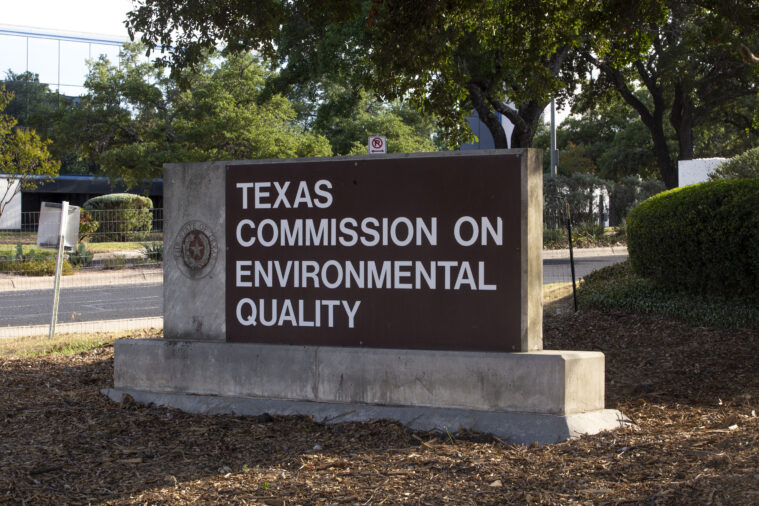
“There are strong economic incentives for firms to want to avoid being classified as major,” said Cary Coglianese, director of the Penn Program on Regulation at the University of Pennsylvania.
“If the state turns to look the other way, the permit requirements for these sources, deemed as ‘minor,’ could be much less costly to meet.”
The EPA foresaw this problem in its 1990 air permitting manual, labeling such authorizations as “sham permits.”
“If a source accepts operational limits to obtain a minor source construction permit but intends to operate the source in excess of those limitations once the unit is built, the permit is considered a sham,” the manual said.
“Additionally, a permit may be considered a sham permit if it is issued for a number of pollution-emitting modules that keep the source minor, but within a short period of time an application is submitted for additional modules which will make the total source major,” it said.
In most areas, applications to build major pollution sources trigger a federal program called Prevention of Significant Deterioration, or PSD, which has four main requirements: pollution control technology, air modeling, impact analysis and public involvement.
Stricter standards apply in areas with poor air quality — like Greater Houston — where the EPA has determined “nonattainment” of federal air standards. There, a program called “Nonattainment New Source Review” is supposed to prevent new industrial developments from exacerbating the situation. It has three main requirements: demonstration of the “lowest achievable emission rate,” purchase of pollution offsets and public participation.
“If you can skate by without triggering major source thresholds you don’t have to do that stuff,” said Eric Schaeffer, a former EPA director and head of the Environmental Integrity Project in Washington. “You can save a lot of money and save time.”
‘Suspicious as hell:’ The case of ITC
Today ITC, a Japanese petrochemical storage and loading company, operates its 180-acre Pasadena Terminal and tank farm on Buffalo Bayou, less than 10 miles from downtown Houston.
Case records accessed via TCEQ databases show the agency knew ITC planned to build a major source and pushed back hard against the company’s attempts to avoid major source permitting. Eventually, and inexplicably, the TCEQ relented and permitted the Pasadena Terminal as three independent “minor” sources, each barely beneath the major source threshold.
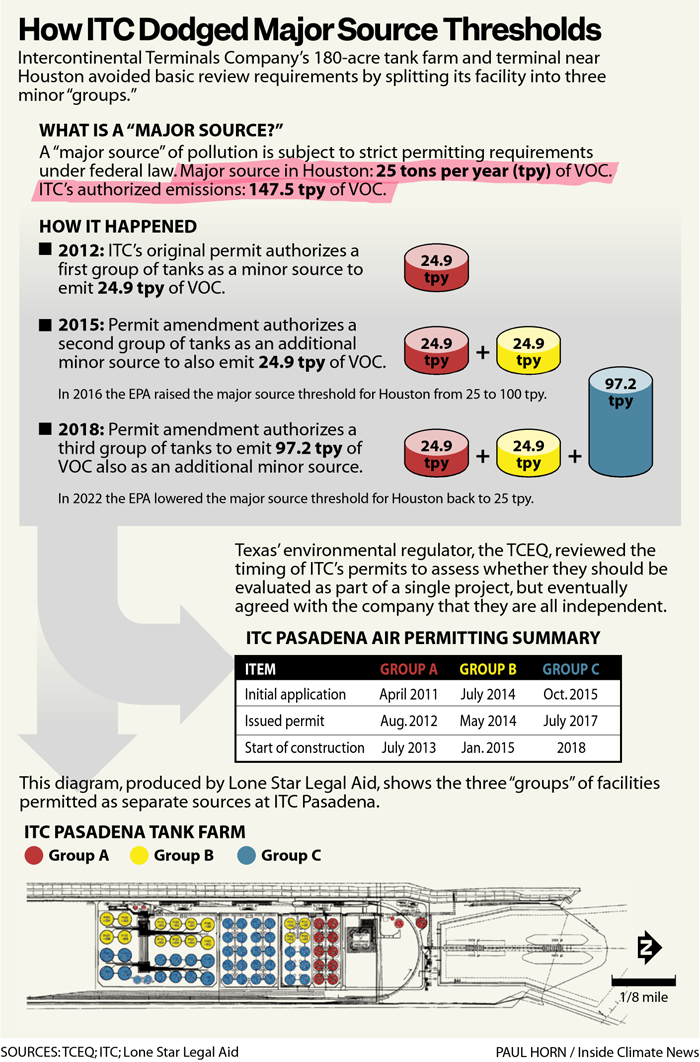
“It is suspicious as hell when you have three emissions units approaching the (tons-per-year) threshold for major source permitting,” said an air permitting consultant in Texas who reviewed the case summary and requested anonymity to preserve business relationships with the TCEQ and his clients.
The story started in 2011, when ITC sought its first pollution permit to build boat docks, a railyard, a truck terminal and 22 massive chemical tanks at the Pasadena Terminal.
Because the EPA considered Greater Houston in “severe nonattainment” of federal air quality standards, it set the region’s major source threshold for volatile organic compound emissions relatively low, at 25 tons per year. ITC applied to authorize 24.9 tons per year as a minor source.
The TCEQ, when it issued the permit in 2012, knew ITC had bigger plans in mind.
“ITC is authorizing the initial construction of what they plan will be a large tank terminal,” wrote Kurt Kind, a TCEQ engineer, in his review of the permit. “Although the site will ultimately be major, this initial construction will be limited to volatile organic compound emissions to less than 25 [tons per year] so that the site is minor.”
‘Group B’
Two years later, ITC asked to add 19 more tanks. The project would also emit 24.9 tons per year of volatile organic compounds, the application claimed, and should be evaluated as an independent, minor source.
The application went to Lovegren, the TCEQ permit reviewer who expressed concern over circumvention of a major source review. It was difficult to see how ITC’s two projects could be considered separate, he wrote in a 9-page memo sent in July 2014. Evaluated collectively, Lovegren wrote, they would need to undergo Nonattainment New Source Review.
Repeated follow ups with the firm preparing ITC’s application, DiSorbo Consulting, failed to satisfy Lovegren’s concerns. “Overall analysis is tilted away from ITC’s favor,” he wrote in September.
The next month, TCEQ air permits director Mike Wilson joined Lovegren for a tense meeting with Shanon DiSorbo, head of DiSorbo Consulting and a former TCEQ air permit engineer, to negotiate a path forward.
“You and ITC have been unequivocal in saying that your first priority is to avoid (Nonattainment New Source Review),” said prepared remarks for the October 13 meeting. “It is not our place to guide applicants through loopholes (much less create new loopholes).”
“You’re destroying ITC,” DiSorbo told Wilson, according to meeting minutes.
After that, the TCEQ mysteriously changed its tone and agreed to permit ITC’s expansion as an independent minor source, which it dubbed “Group B.” Per the agreement, ITC reduced the scope of its initial permit, withdrew its latest permit application and re-submitted the project as an amendment to the original permit. It remains unclear how those actions satisfied the agency’s concerns, and the TCEQ declined to answer questions.
Lovegren, in his January 2015 review of the expansion permit, said ITC took those actions “in order to remedy concerns about circumvention of nonattainment review, but still avoid undergoing nonattainment review.”
‘Group C’
Nine months later, ITC applied for another, larger expansion, including 40 more tanks and another 79 tons per year of volatile organic compound emissions (later increased to 97.2 tons per year through a permit amendment).
DiSorbo Consulting, which again prepared the application, called it “Group C.” This time, it would be a major source, subject to Nonattainment New Source Review.
However, two months prior, the TCEQ had asked EPA to remove Greater Houston’s designation as a “severe” nonattainment region for federal ozone standards, citing improving air quality. In November 2016, the EPA concurred, reclassified Greater Houston as “moderate” for nonattainment and raised the major source threshold for volatile organic compounds emissions from 25 to 100 tons per year.
“The Pasadena Terminal is now a minor source … and the expansion project does not constitute construction of a new major source,” Lovegren wrote in his review of the Group C expansion. “Nonattainment review is not required.”
TCEQ issued the permit in July 2017, bringing the Pasadena Terminal’s authorized emissions, under three separate “minor source” permits for 24.9, 24.9 and 97.2 tons of volatile organic compounds, respectively, up to 147 tons per year, well above the new “major source” level of 100 tons per year.
“There is no indication that ITC has improperly avoided major NSR review,” Lovegren wrote.
The next year, he left the TCEQ to work for DiSorbo.
In 2022, amid worsening air quality, the EPA redesignated Greater Houston as “severe nonattainment,” returning the major source threshold for volatile organic compound emissions to 25 tons per year. But ITC’s minor source permits, based on the applicable threshold at the time of application, remained in place, even with the threshold back to 25 tons.
Also in 2022, the TCEQ approved renewal of ITC’s sitewide operating permit over objections from environmental lawyers and community members. After that, Clark-Leach, the former staff attorney for the Environmental Integrity Project, filed his petition with the EPA.
“ITC’s plan was to parse construction of its major source into a series of minor projects, none of which involved an emission increase sufficient to trigger NNSR preconstruction permitting requirements.”
“ITC’s plan was to parse construction of its major source into a series of minor projects, none of which involved an emission increase sufficient to trigger NNSR preconstruction permitting requirements,” it said.
The TCEQ, it said, “anticipate(d) that the Terminal would be operated as a major source” and “also anticipated that ITC would attempt to authorize subsequent phases of the Terminal’s construction in bits and pieces to circumvent NNSR.”
An EPA spokesperson said the agency expects to issue its response in early 2024. ITC did not respond to requests for comment.
Dividing sites is a common tactic to avoid major source permits, Clark-Leach said. He worked a similar case against Enbridge Energy, a $180 billion Canadian oil and gas company, and its Ingleside Energy Center on Corpus Christi Bay.
Three times the TCEQ denied requests to split the center’s oil and gas operations into separately permitted sites: July 2021, September 2021 and January 2022.
Then the consultant preparing Enbridge’s application shared a 3-page memo by a downtown Houston lawfirm, copying Jeff Saitas, a former TCEQ executive director and a lobbyist for oil companies, in the email.
After that, the TCEQ agreed to separate the sites. Clark-Leach challenged that determination in official comments in July 2023. A spokesperson for Enbridge said the company was “following federal and state regulation by treating the Oil Terminal and LPG Terminal as separate sites.”
When neighbors speak up: The case of GAF
Even if state regulators fail to adequately scrutinize pollution permit applications, the Clean Air Act provides a backup: public participation. Federal law includes detailed requirements for community engagement in major source permits, which can bog developers down in challenges to their applications that wouldn’t otherwise have arisen.
In some cases, public participation can win major concessions from industrial developers. For example, the 80-year-old GAF shingles factory in West Dallas faced protests from neighbors, state representatives and federal regulators when it sought to renew its major source pollution permit in 2021.
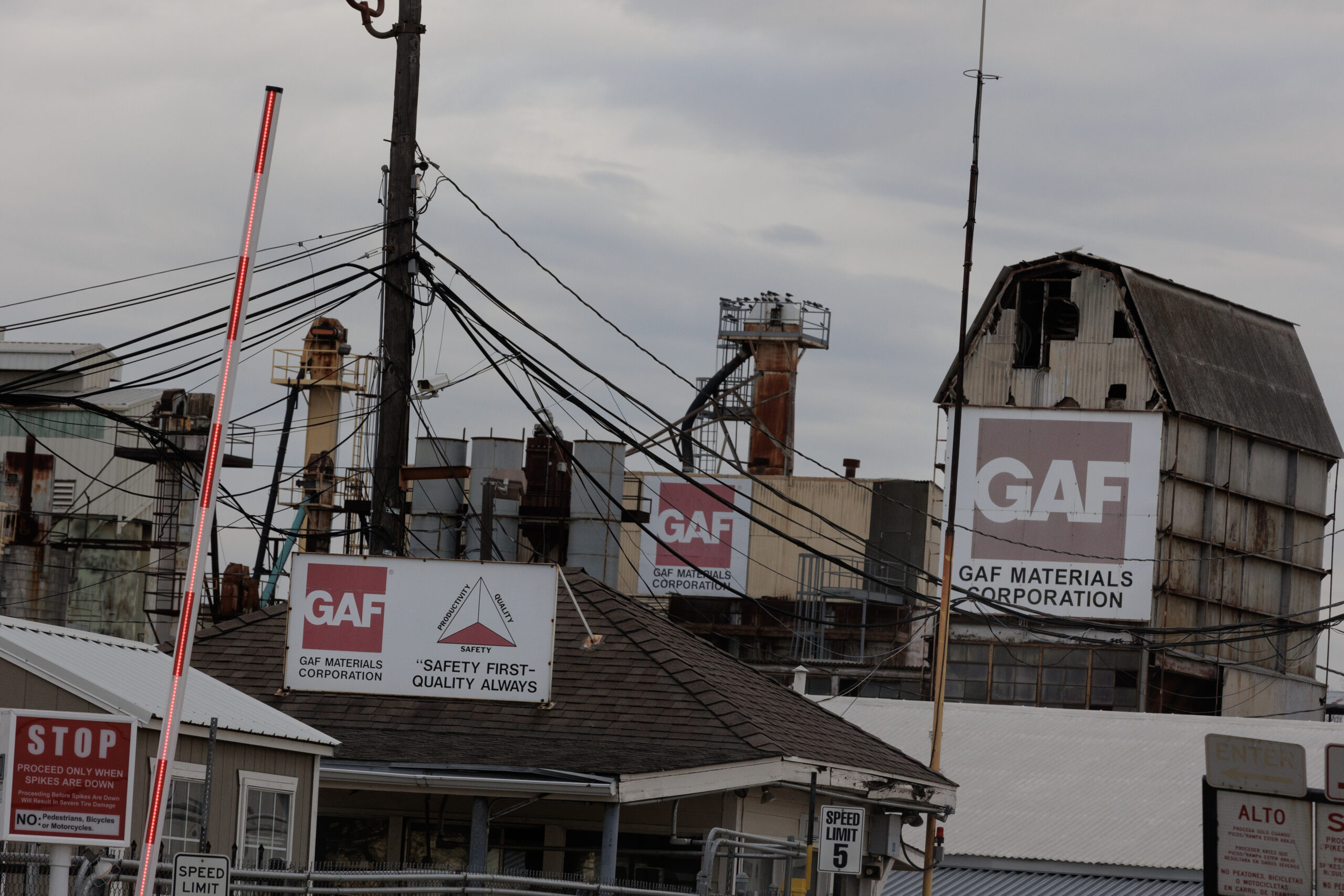
GAF held a major source permit to emit up to 129 tons per year of sulfur dioxide, a gas known for its stinging, choking odor. In 2020, GAF was the top sulfur dioxide emitter in Dallas County (population 2.6 million), according to an inventory of self-reported emissions by Paul Quinn College’s Urban Research Initiative in Dallas. It also ranked second for particulate matter and fourth for overall emissions.
According to Janie Cisneros, 41, a mother and digital product designer who grew up in West Dallas, frustration grew for decades over the relentless stench that infiltrated the homes of residents who believed the company’s emissions were causing problems from asthma to bronchitis to throat cancer.
When GAF sought a routine renewal of its major source permit in 2021, the community had a chance to speak up. They lobbied public officials, who requested TCEQ hold a public hearing on the community’s behalf—part of the major source review process. Then, Cisneros, who was starting her environmental organizing work, and other neighborhood advocates helped people in West Dallas prepare remarks and attend the online hearing.
We were just over the moon. I had so much hope.
At the hearing, in July 2021, dozens of residents tuned in and took turns for hours speaking about the fears and frustration of life near the factory. Elected officials and lawyers also testified against the permit.
TCEQ dismissed their protests and approved GAF’s permit renewal in June 2022, then sent it to the EPA for review—part of major source permit requirements.
EPA responded in August with 16 pages of objections. The agency cited the neighborhoods’ “dozens of comments involving concerns of routine nuisance conditions” including noxious odors, dust plumes and “waxy black substances.”
The EPA also said GAF used outdated measurements in its emissions calculations, and noted that the permits should include requirements for monitoring, record keeping and periodic testing to ensure compliance with permit limits.
Unless TCEQ submitted a revised permit to address the objections within 90 days, wrote EPA air and radiation division director David Garcia, the application would be denied.
Cisneros was elated. Federal authorities had stepped in to support the fight of her historically marginalized community.
“We were just over the moon,” Cisneros said. “I had so much hope.”
But the EPA’s objections would get no response.

Instead of taking the outlined steps and revising its major source permit application, GAF filed a notice for TCEQ to void its major source permit and applied instead for a minor source permit. To do that, it proposed to retire one of its two production lines and reduce other sulfur dioxide emissions below the major source threshold—from around 129 tons per year to approximately 80 tons.
According to a company spokesperson, “GAF became aware of public concerns regarding its emissions … in the West Dallas community” during public comments in 2021.
“In response to these concerns, GAF began to formulate a plan to reduce its emissions,” the spokesperson said in a statement. “GAF did not apply for a minor source permit because EPA rejected the [major source] permit; on the contrary, GAF voluntarily reduced its emissions and became a minor source to help alleviate public concerns.”
Wendi Hammond, a staff attorney for the nonprofit Legal Aid of Northwest Texas, disagrees.
Line 1, which the company proposed to retire, hadn’t been used since 2017, according to the TCEQ’s review of GAF’s application. So, Hammond said, there wasn’t anything substantial to retire in 2022.
“The minor source review application was essentially just a paper exercise to try to get out of major source review,” Hammond said.
And it worked: GAF remains in operation under a minor source permit.
“You smell that?” said Cisneros, scrunching her nose as she walked through her neighborhood’s old wooden houses decked out in Christmas lights, wearing her signature cherry lipstick and gold hoop earrings.
She was left shaking her head at GAF’s permit maneuver, which was a frustrating setback for her and others who live nearby the plant.
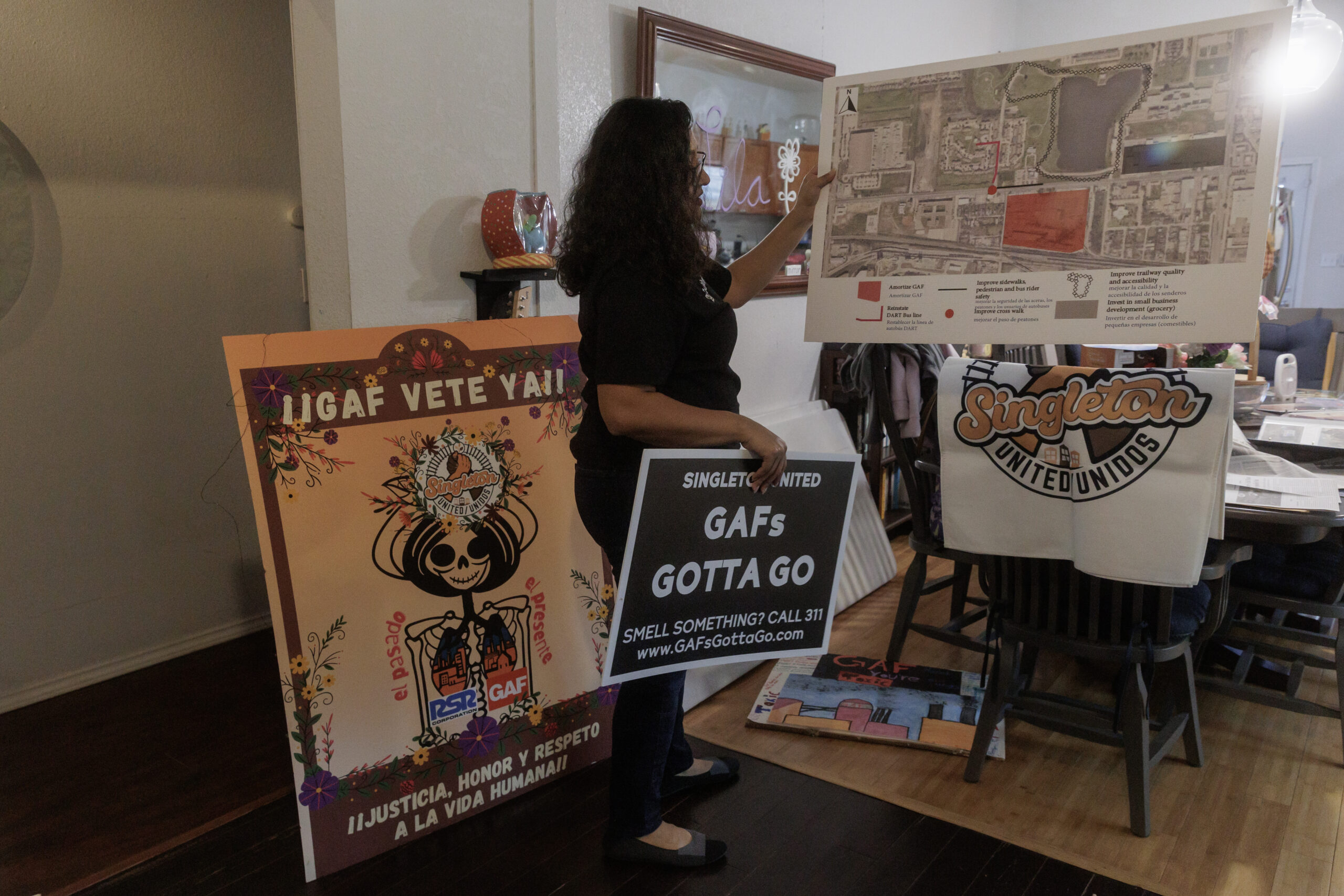
“I was confused and taken by surprise,” Cisneros said. “I didn’t know [GAF] could just reduce emissions and get away with that. [Regulators] are not willing to investigate further.”
‘Rarely any consequences’
It’s impossible to know how frequently companies misclassify themselves as minor sources, said Colin Cox, another former staff attorney for the Environmental Integrity Project.
That’s because Texas, which issues thousands of pollution permits each year, has just a few independent watchdogs who scrutinize applications — about 10 attorneys for nonprofits like EIP, Legal Aid and EarthJustice, plus a few private firms that challenge permits for paying clients.
If the TCEQ doesn’t object to a developer’s claim, it’s relatively unlikely that anyone else will.
“The commission doesn’t like it when you double check their homework. They rely on this process being super complicated to get away with what they do.”
“The commission doesn’t like it when you double check their homework. They rely on this process being super complicated to get away with what they do,” Cox said.
Last year, he challenged a minor source determination for the Ingleside Terminal, a oil export terminal owned by Flint Hills, a subsidiary of Koch Industries, on Corpus Christi Bay.
In a lawsuit filed November 2022 in state district court, Cox alleged Flint Hills used a retroactive “as-built” amendment, meant to authorize design changes made during the construction process, to loosen limits in a previous minor source permit, such that it became major.
First, in 2018, Flint Hills applied to expand its terminal, adding six new tanks and four new vapor combustors. It asked to authorize 39.7 tons per year of sulfur dioxide emissions (below the major source threshold of 40) in two parts: 37.4 tons per year of routine emissions and 2.3 tons per year for emissions from maintenance activities.
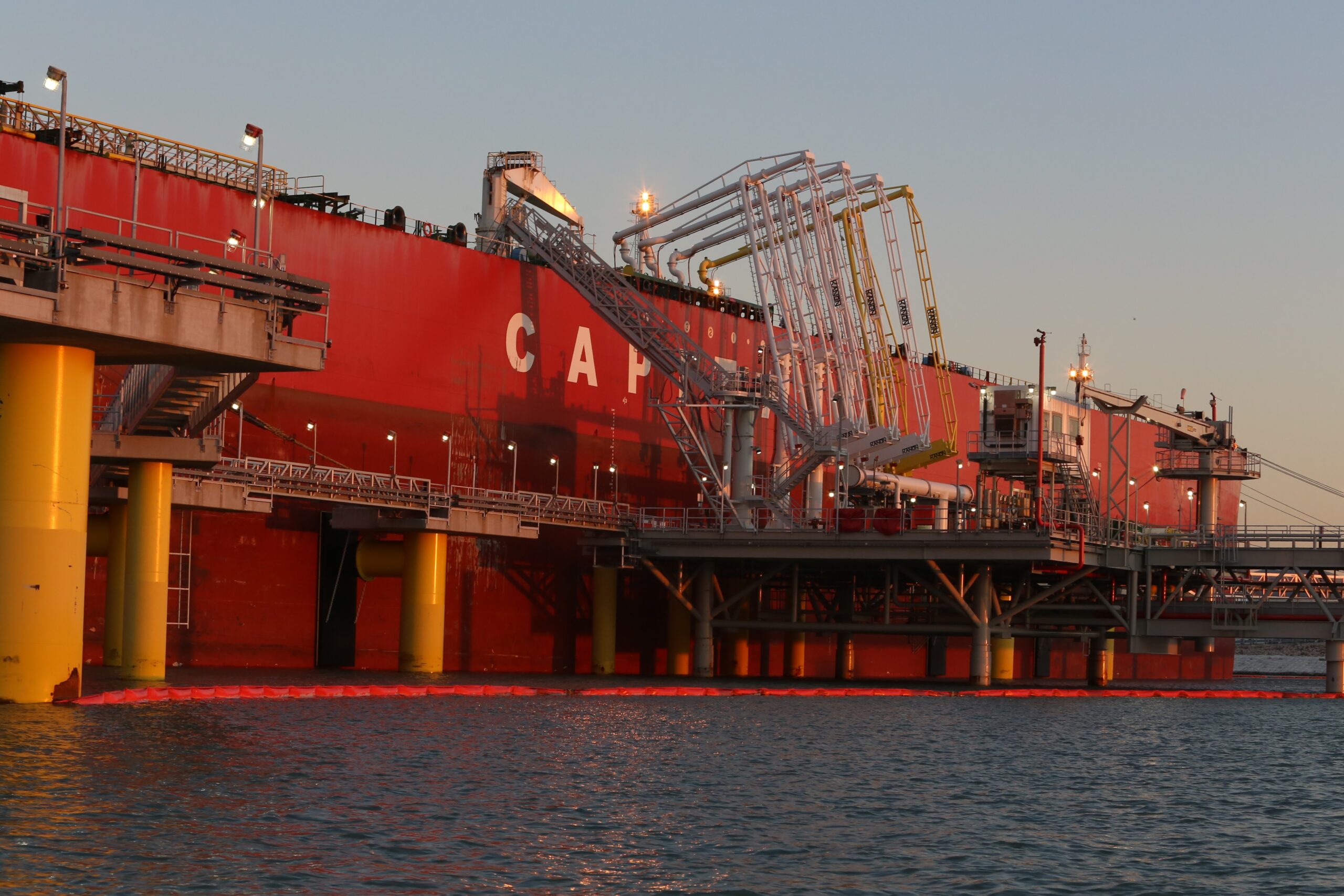
Then, in 2021, Flint Hills sought an “as-built” amendment to significantly increase operations in the newly built expansion. It asked to only slightly raise routine emission limits on its new tanks and combustors to 38.1 tons per year of sulfur dioxide. But in that application, Flint Hills excluded the 2.3 tons of maintenance emissions previously authorized for those same units. So, the expansion project remained a minor source.
“Despite the major modification status of the Amendment, Flint Hills and TCEQ processed it as a minor modification and failed to conduct the mandatory federal Prevention of Significant
Deterioration review or provide all required public participation opportunities,” Cox wrote in his complaint.
According to a spokesperson for Flint Hills, maintenance emissions weren’t included in the 2021 application because the proposed amendment didn’t cause them to increase.
He pointed to a 22-page legal argument Flint Hills filed with the TCEQ, which said, “No new tanks were required for the project and therefore no new tank maintenance emissions were required to be authorized.”
“Our priority with respect to permitting is to follow applicable rules and regulations, and to use the methods specified by those rules to determine what form of permit is required,” the spokesperson said.
The lawsuit is still pending.
Cox, who grew up in Houston and went to law school at the University of Texas, Austin, left the EIP this year, moved to the woods of northern New Mexico and took a job with the Center for Biological Diversity.
“Texas is a challenging place to do environmental work,” he said. “The TCEQ and its commissioners are completely captured by industry. They bend over backwards to break the law and grant permits. And they do it unashamedly because there are rarely any consequences.”
The explosive case of Freeport LNG
Also on the Gulf Coast, the case of Freeport LNG, operator of a new liquified natural gas terminal 40 miles south of Galveston, represented yet another attempt to avoid major source review by splitting plant operations in two, even if that meant dramatically understating emissions from the LNG facility.
“The TCEQ has repeatedly allowed construction of industrial sources based on obviously unrealistic representations,” read a 2023 EIP report called “The Polluter’s Playbook: How Loopholes and Lax Enforcement Harm Air Quality in Texas.”
“Even if Freeport LNG did not intentionally misrepresent the amount of pollution its source would emit,” the report said, “the company was still allowed to build, operate, and nearly destroy a facility it did not understand.”
Freeport LNG, a project of New York billionaire Michael Smith, received a permit in 2014 to build its giant gas liquefaction and export terminal as a major source of nitrogen oxide emissions.
Later, it asked to separate its proposed liquefaction plant from its pretreatment plant as a minor source. So when it applied to expand that liquefaction plant, it didn’t require tedious review.
In 2018, TCEQ issued a minor source permit for the plant, authorizing nitrogen oxide emissions of 6 tons per year.
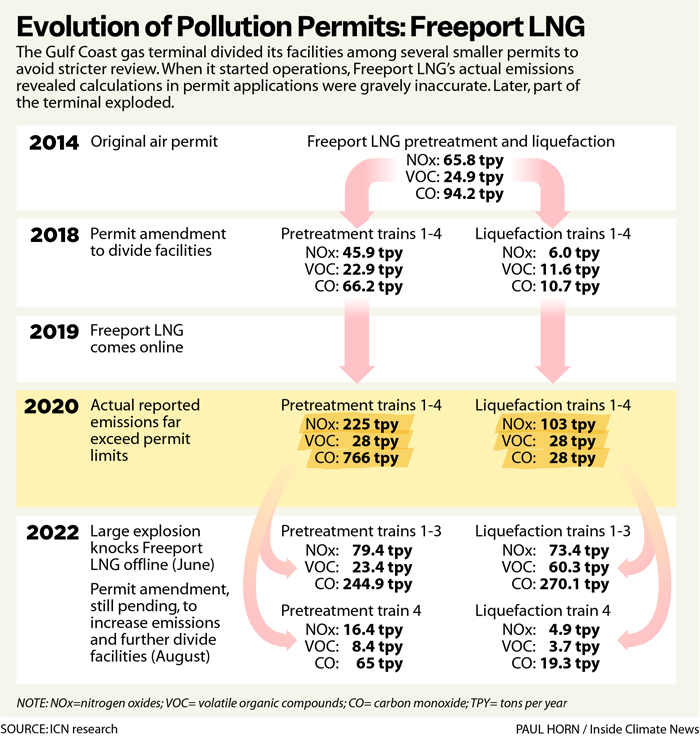
In 2019, when that plant began operations, it reported nearly 119 tons of unexpected nitrogen oxide emissions to the TCEQ. In 2020 it reported 103 tons. At the time, the major source threshold for nitrogen oxide, a potent greenhouse gas and respiratory irritant, was 25 tons.
In 2022, part of the liquefaction plant exploded when leaking gas caught fire. Federal investigators attributed the disaster to poor management and human error.
After the explosion, Freeport LNG asked for “as-built” amendments that would drastically increase permit limits to account for emissions “that have become known through actual operations of these facilities.” In the applications, Freeport LNG asked to further divide both of its projects, reclassifying its fourth compressor units at each plant as separate, minor projects from compressor units 1-3.
Those applications are still pending. Freeport LNG declined to answer questions for this report.
‘Synthetic minor:’ The vase of Max Midstream
Down the coast on Lavaca Bay, another export terminal also faces allegations of improper classification as a minor source based on unrealistic emissions assumptions.
When Max Midstream applied in 2020 to expand its Seahawk oil terminal as a minor source, environmentalist groups argued in official comments to the TCEQ the expansion was a major source because it had “potential to emit” above applicable thresholds, even though the operators promised to run it below those levels.
TCEQ dismissed their claims and issued the permit after lawyers for Max Midstream invoked the agency’s controversial “one-mile rule,” claiming that permit opponents lacked standing because they lived more than a mile away from the plant. So, the groups sued.
“TCEQ’s issuance of Max Midstream’s minor source air permit was invalid, arbitrary, or unreasonable,” wrote Erin Gaines, an attorney for the nonprofit EarthJustice, in a legal brief filed in July 2023 in state district court. “The Terminal is a major stationary source.”
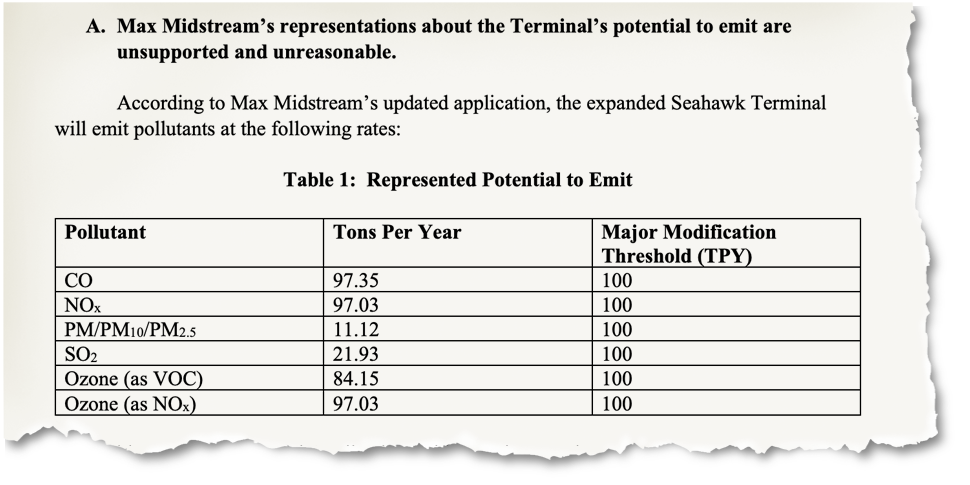
For example, the lawsuit said, 20 vapor combustors authorized in the expansion permit could potentially emit up to 405 tons per year of volatile organic compounds if run year-round at full blast–well above the major source threshold of 250 tons. But the permit set emission limits for volatile organic compounds from those units at 17.3 tons per year.
That’s what TCEQ guidance documents call a “synthetic minor”—“a source that would normally be a major source, with the exception that the source is held to emission rates that are less than major source.”
In the lawsuit, Gaines argued the TCEQ’s synthetic minor permit failed to include “practically enforceable limits” (as defined by the EPA) to prevent the facility from exceeding its limits, or basic monitoring requirements to ensure limits were being met.
This November, the judge in the case struck down the TCEQ’s previously issued permit for Max Midstream and ordered the agency to hold a hearing on the claims made by Gaines and others.
Gaines worries the TCEQ will bog the ruling down in lengthy appeals, during which time the permit will remain valid. Still, it was a rare kind of victory in her fight against big polluters, which is often fraught with frustration.
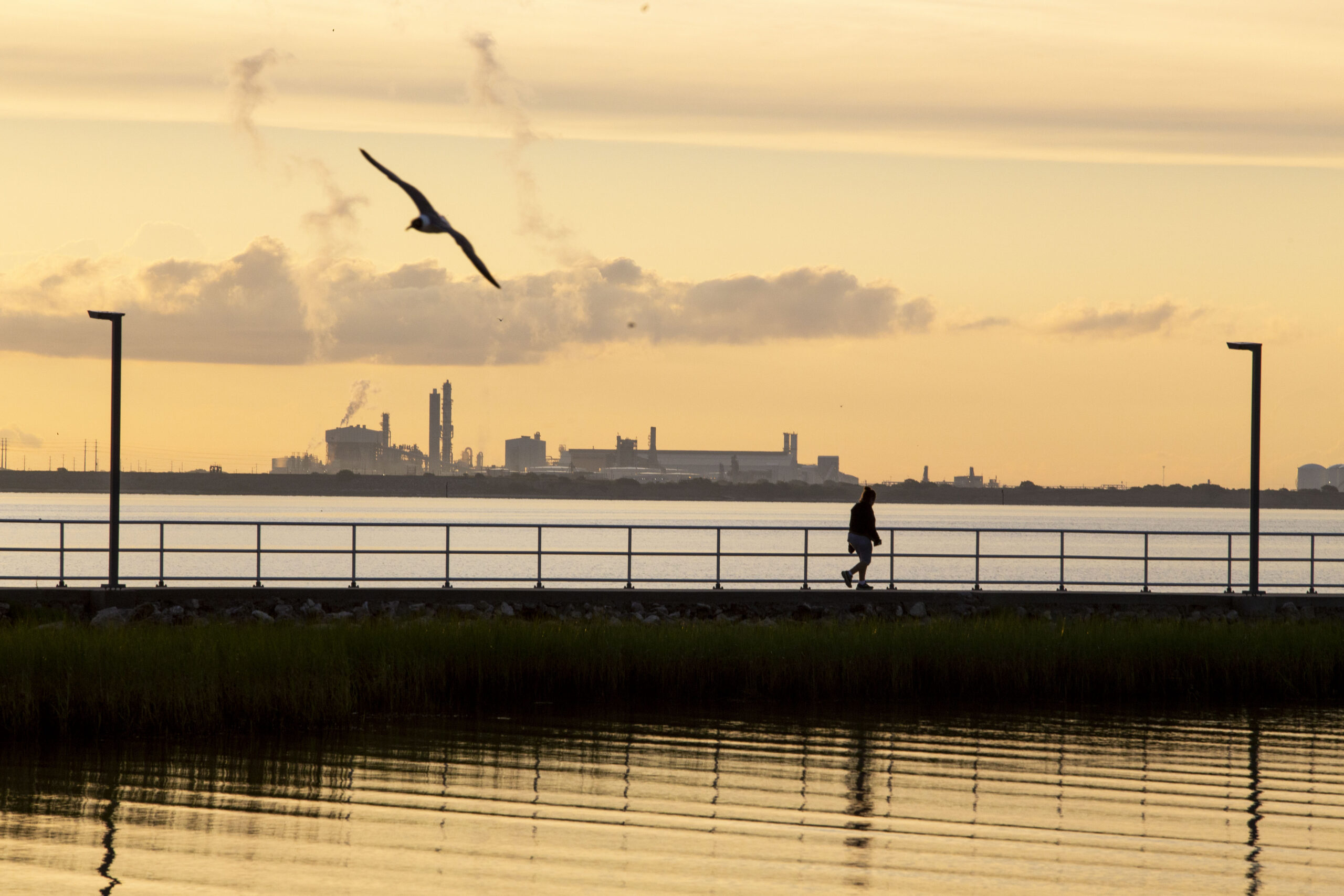
Gaines and her colleagues have filed numerous petitions in recent years with the EPA alleging systemic abuses of federal environmental law in Texas, but they are yet to see any action in response.
“The deck is definitely stacked against us and we need more engagement from EPA on these issues,” she said. “Let’s not just give up on enforcing federal laws in this region.”
The EPA spokesperson, Durant, said the agency follows legal procedures when reviewing petitions “which can take a considerable amount of time.”
“The agency understands this can be frustrating for petitioners, which is why we are moving expeditiously to respond,” she said.
EPA intervenes: Seawater desalination at the Port of Corpus Christi
In a rare instance when the EPA did step in—for a while, at least—the agency objected to the issuance of a desalination permit, only to have the TCEQ disregard its objection.
The dispute centered on a seawater desalination facility proposed by the Port of Corpus Christi to meet projected water demand from a booming industrial buildout.
Charles Maguire, director of the EPA water division, said in a December 2021 letter to the TCEQ that the plant, which would dump millions of gallons of extremely salty brine into Corpus Christi Bay, had been “incorrectly classified as a Minor facility.”
“The EPA has determined that the facility should be classified as a Major facility,” Maguire wrote.
The problem, he explained, was the TCEQ’s classification of the facility’s effluent.
It proposed to discharge up to 110,000,000 gallons of brine daily into Corpus Christi Bay, 2,200 times above the 50,000 gallon-per-day threshold for major sources of water pollution. However, the TCEQ labeled that discharge “non-process wastewater” (“wastewater streams not associated with a production process,” according to federal law), so it didn’t count towards the tally.
Maguire said the brine in question was a “waste product resulting from the production of potable/drinking water” and should be considered “process wastewater.”
“If POCC’s discharge is properly classified as process wastewater … the rating of the facility changes from Minor to Major,” he wrote.
Regardless, the commissioners voted unanimously in September 2022 to issue the permit as proposed. In response, EPA Region 6 administrator Earthea Nance refused to recognize the permit and accused the TCEQ of “a violation of (the) Clean Water Act” in a January 2023 letter.
Seven months later, the TCEQ sent a letter responding to most of the EPA’s comments, but said that the issue of whether the desalination plant should be operating under a major or minor permit “requires further discussion between the agencies.”
A month after that, the EPA dropped its objections.
‘Upset’ emissions
Another tactic highly polluting facilities employ to avoid major source classification, environmental advocates argue, relies on the TCEQ’s lenient regulation of “upset emissions,” which Texas regulators define as unexpected emissions from accidents, unscheduled maintenance, or start up and shut down activities. Because these events are considered exceptional and beyond the control of the company, they are not counted toward a source’s classification as major or minor and are not regulated in permits.
The Environmental Integrity Project has documented how the TCEQ rarely follows up when companies report upset emissions to analyze the cause of the problem and make sure it doesn’t happen again. EIP argued this year in its Polluter’s Playbook report that the TCEQ’s handling of these upset events allows companies to “escape consequences” for chronic illegal pollution.
The EIP report uses the example of a Chevron facility, the McElroy Section 199 Emergency Flare in Crane County, to illustrate how companies can circumvent major source permitting requirements by relying on what they characterize as the upset emissions loophole.
The McElroy flare is only authorized to emit less than 0.01 ton per year of sulfur dioxide, a severe respiratory irritant, which would only account for the emissions of the pilot light for the flare, not the flaring of gas itself during emergencies or maintenance. However, Chevron consistently reports emissions far in excess of this annual permit limit, but writes them off as “upset events.” In 2017, 2018, 2019 and 2020, these excess emissions surpassed the threshold for major source permitting for sulfur dioxide of 250 tons a year.
As long as Chevron reported these emission events as leaks, accidents and other types of non-routine operations to the TCEQ, they did not count toward the facility’s permit limits. The EIP report argues the McElroy flare is an example of TCEQ issuing permits with “unrealistic” emissions expectations.
In 2021 and 2022, the McElroy flare reported 215 and 139 pounds of sulfur dioxide upset emissions respectively. While below the major source threshold, these emissions are still many times more than the facility’s permit allows.
Chevron external affairs advisor Deena McMullen said the McElroy facility is now enrolled in the TCEQ’s “Find It and Fix It” program, a voluntary initiative for companies to address compliance issues.
“As part of the program, Chevron is investing in operational changes to minimize potential emissions,” McMullen said.
Another similar case is Scout Energy Management’s Mabee Ranch CO2 Plant in Andrews County, which has a minor source permit with a threshold of 2.49 tons per year of sulfur dioxide. Based on TCEQ data, in 2016, 2017 and 2018 the facility reported upset emissions events of sulfur dioxide of more than 250 tons, exceeding the major source limit. Emissions from 2019 to 2022 were below 250 tons but still well above the facility’s permit.
Scout Energy did not respond to a request for comment.
The case of Exxon Baytown
Of the hundreds of cases he worked on, Clark-Leach, the former EIP lawyer, said the most frustrating involved ExxonMobil and its sprawling Baytown Complex, which covers more than five square miles along the Houston Ship Channel.
In filings to the TCEQ and a petition to the EPA, Clark-Leach fought ExxonMobil, the largest U.S. oil company, for almost 10 years, arguing it improperly avoided major source review for additions to the Baytown Olefins Plant. But he seldom claimed victories.
“They’re really good at manipulating, at using the state process,” he said. “They’re just going to pour money into appeals until they get it, until they win or the world comes to an end.”
The olefins plant—one of three plants in its Baytown Complex— manufactures approximately 10 billion pounds of petrochemical products every year.
Exxon operates the olefins plants under a permit called a “Plantwide Applicability Limit,” originally issued in 2005. The permit authorized it as a major source, but instead of setting specific emissions limits for dozens of point sources, it set cumulative limits for the entire facility, including 2,610 tons per year of nitrogen oxides, 2,381 tons per year of carbon monoxide and 435 tons per year of volatile organic compounds.
In 2016, Clark-Leach of EIP, along with the Sierra Club and Air Alliance Houston, petitioned the EPA to object to a revision to the permit. He argued that TCEQ erred in issuing a separate minor source air permit for a 2012 expansion project at the olefins plant.
By setting artificially high limits in that 2005 permit, Clark-Leach argued, TCEQ enabled Exxon to avoid a major source review for its expansion project.
The EPA declined to review Exxon’s 2005 PAL permit and a circuit court of appeals upheld the federal agency’s decision. In 2022, the TCEQ renewed the Plantwide Applicability Limit permit for ExxonMobil.
“We lost that opportunity. We lost our ability to appeal,” Clark-Leach said. “We relied on the EPA answering our arguments and dealing with the issues.”
Most recently, Exxon applied in 2022 to build a new ethylene unit as a minor modification at its olefins plant within the overall limits of the PAL permit, even though the unit would most likely exceed the major source threshold if it were required to undergo a major source review.
“Here we are in 2023,” Clark-Leach said. “Exxon’s still relying on this bogus [Plantwide Applicability Limit] permit that they got back in 2005 to authorize major [modification] after major [modification].”
Other environmental groups continue to challenge Exxon’s permits, but for Clark-Leach, his decade of often fruitless struggle became too exhausting. Since he left the EIP, he’s been trying to think of new ways to fight this fight, because, he said, the old ways weren’t working.
A spokesperson for ExxonMobil said the company has followed proper permitting processes at its Baytown Complex. “Complying with all applicable laws and regulations related to our operations is important in our work,” the spokesperson said.

